Free shipping
For orders over 50€.
User services
Pre and post sales advice
BIPAP VIVO 3
4.785,00€
Vivo 3 is designed to provide invasive or non-invasive ventilation to patients weighing more than 10 kg who require long-term mechanical ventilation or support for respiratory failure or respiratory insufficiency, with or without obstructive sleep apnoea.
Vivo 3 is indicated for patients with spontaneous breathing.
MEDICAL PRESCRIPTION REQUIRED
Learn more about the product- Description
- Reviews (0)
- ESPECIFICACIONES TÉCNICAS
Description
Breas Vivo 3
BREAS VIVO ventilators are BIPAP respiratory ventilators designed for patients with chronic respiratory insufficiency or respiratory failure.
There are different devices within the BREAS family depending on the needs of the patient. There are the VIVO 1, VIVO 2, VIVO 3, VIVO 45.
All ventilators are designed to assist the patient with chronic respiratory insufficiency or respiratory failure by maintaining adequate levels of carbon dioxide in the blood.
How does the Breas Vivo 3 work?
The Vivo 1 ventilator is designed for patients weighing more than 10 kg. It has the following ventilatory modes: PSV/ CPAP/ ST. The maximum and minimum pressure provided by the device is 4-25 cmH2O.
The Vivo 2 ventilator is also designed for patients weighing 10 kg or more. It has the following ventilatory modes: PSV/ CPAP/ ST / T / Tgv. The maximum and minimum pressure provided by the device is 4-30 cmH2O. Assured Volume of 100-1500ml.
The Vivo 3 ventilator is also designed for patients weighing 10 kg or more. It has the following ventilatory modes: PSV/ CPAP/ ST / T / Tgv.
The maximum and minimum pressure provided by the device is 4-40 cmH2O. It has an Assured Volume of 100-1500ml. In addition, it has a removable battery of 4h of duration.
The Vivo 45 ventilator is designed for nocturnal use and activities. It has multiple ventilatory modes both invasive and non-invasive, in addition, it includes Auto EPAP algorithms and is mouth pipette compatible with PVC mode. It offers the possibility of integrated polygraphic monitoring by means of: SpO2, FiO2, CO2, respiratory effort bands. It has a 2.5h battery to which a 6.5h battery can be added.
The BREAS family offers easy-to-use in-hospital and home telemonitoring of the patient, allowing the healthcare professional to observe the following parameters in real or deferred mode:
– respiratory rate,
– peak pressure
– tidal volume (the amount of air delivered with each breath),
– inspiratory and expiratory times,
– other settings based on the patient’s needs and condition.
Respiratory treatments with Breas Vivo 3
The BREAS family can be used to treat or manage a wide range of respiratory conditions, such as:
– chronic obstructive pulmonary disease (COPD),
– respiratory muscle weakness
– neuromuscular disorders,
– obstructive sleep apnoea (OSA),
– acute respiratory distress syndrome (ARDS),
– postoperative,
– trauma.
The device is portable and lightweight, with the humidifier built into the device itself, so patients can use it comfortably at home or on the go.
The BIPAP Breas Vivo ventilator allows data to be downloaded to a computer for monitoring respiratory therapy.
Buying a BIPAP Breas Vivo ventilator from the TerapiaCPAP shop has many advantages:
– Fast delivery;
– Possibility of financing;
– Installation of the equipment at home by specialised personnel;
– After-sales customer service;
– Annual maintenance of the BIPAP equipment (check of operation, change of filters, sanitation);
In addition, we have several accessories for Breas Vivo:
– Transport bag;
– Batteries;
– Heated humidification circuit.
How do portable oxygen concentrators work?
The basic principle of an oxygen concentrator relies on the separation of oxygen from the ambient air. There is approximately 79% oxygen and 20% oxygen in the ambient air. The concentrator filters out the concentrated oxygen molecules and provides patients with 90% to 95% oxygen.
Inside the concentrator are two sieve beds, one of which removes nitrogen from the ambient air and the other releases oxygen into the cylinder. In addition, the pressure valve maintains the oxygen supply flow between 5 and 10 litres per minute.
The oxygen generated inside the cylinder is subsequently delivered through the nasal cannulae.
Features of portable oxygen concentrators
Portable concentrators are BATTERY powered and smaller. They have a shoulder harness, among other options.
Portable concentrators give you oxygen by ‘pulse dose’, which means that oxygen comes out in small bursts each time you inhale. Some models can give you oxygen at a constant flow.
The two main differences between fixed and portable concentrators are their size and flow rate (portable models deliver 1 to 5 litres per minute).
Portable oxygen concentrators provide greater flexibility for respiratory patients who do not require high doses of oxygen. They can operate from a variety of power sources and can be charged from a wall outlet, car adapter or battery.
Portable concentrators are often considered a complement to a home concentrator, rather than an alternative, as they offer the patient the safety and reliability of the stationary model and the freedom of the portable model.
COMPACT
– One platform – Three models
– Lightweight and compact
– Integrated humidifier with heated cable loop
ADAPTABLE
– Wide range of Modes
– Adult and paediatric (>10 kg)
– Intuitive interface
– Extensive therapy data
– Suitable for hospital and home use
CONNECTED
For more effective connected care
– EveryWare – Cloud-based connectivity solution (Not included)
– PC Software – Desktop based with Live Viewer (Not included)
Settings / performance
Ventilation modes: PSV, PCV, CPAP, S, S/T, T, TgV
Device Modes: Home, clinical
Inspiratory pressure: 4-40 cm H2O
EPAP: 2-20 cm H2O
Continuous Positive Airway Pressure (CPAP): 4-20 cm H2O
Respiratory rate: 0-40 bpm
Inspiratory time: 0.3-3 s
Ascent time: 1-9
Inspiratory trigger: 1-9
Expiratory trigger: 1-9
Minimum inspiratory time: Off, 0.3-3 s
Maximum inspiratory time: Off, 0.3-3 s
Target volume: 100-1500 ml
Ramp Up: Off, 10-60 min.
Downward Ramp: Off, 10-60 min.
Ramp pressure: 2-20 cm H2O
Humidifier: Deactivated, level 1-5
Heating: Off, level 1-5
Monitoring: Ppeak, EPAP, Leak, MVe, Vte, % em TgV, Total Rate, I:E, Spontaneous Rate,% spontaneous, Inspiratory Time, Rise Time, SpO2



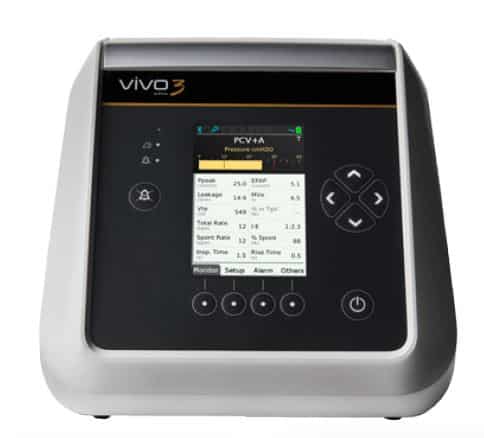
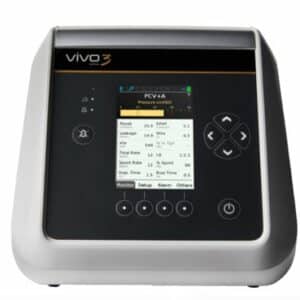
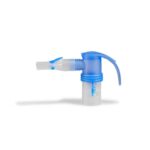
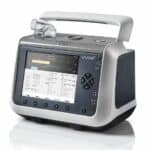
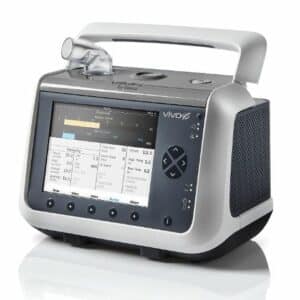

Reviews
There are no reviews yet